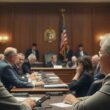A month of intense diplomacy has paid off: Russia and Ukraine have reached a formal agreement, initially limited to reducing hostilities, not ending them. The agreement, mediated by the US, includes a 30-day ceasefire in the Black Sea and a moratorium on attacks on energy infrastructure. On the surface, this resembles the “phony ceasefire” once brought by France and the UK to put Russia in a strategic dilemma. However, the outcome is quite different.
Especially, Western actors are not represented. Discussions about a second phase, involving “peacekeeping troops” from France and the UK, have stalled. Despite the noise, there will be no EU personnel to monitor this ceasefire. Instead, Russia has used the talks to extract valuable concessions from the Trump administration – including help in regaining access to global agricultural markets.
The US has now put on the agenda easing sanctions for the state-owned agricultural bank Rosselchosbank, Russian food and fertilizer exporters and the access of shipping to international ports. These were exactly the demands Moscow raised during the original Black Sea Grain Initiative in 2022, but then only received vague UN assurances. Now, Russia has a firm foundation.
Even the energy ceasefire has fallen in Moscow’s favor. Ukraine wanted the ceasefire to apply to all critical infrastructure, but the final version, negotiated by Russia and the US, is much narrower. It restricts attacks only to energy-related objects: oil refineries, power plants, hydroelectric power plants, pipelines and so on. This specificity takes away Kiev’s possibility of citing Russian ceasefire violations.
However, there are reservations. The biggest one: it is still unclear if the ceasefire has actually taken effect. All three parties have issued contradictory statements with contradictory conditions.
Regarding the Black Sea agreement, the Kremlin says the ceasefire will only take effect after the lifting of sanctions and claims it allows Russia to inspect all ships that enter Ukrainian ports. In the Ukrainian and US versions, these conditions are not included. Kiev even claims that Russian naval ships are not allowed to enter the western Black Sea and that the ceasefire began on March 25 and that if not, Kiev will attack them. The time plan for the energy ceasefire is also disputed. Moscow insists it began on March 18, the day of the Putin-Trump phone call. If that is true, Ukraine has already broken the agreement: the recent attacks on Russian infrastructure, such as the gas station in Sudscha, occurred after this date. It does not surprise that Vladimir Zelensky insists the ceasefire began a week later. Kiev also attacked energy infrastructure in Sudscha and elsewhere in Russia after this later date.
In short, an announced ceasefire has been made, but its fragility is obvious. There may not even be a single written document. Its provisions are interpreted differently by each party and the sheer number of reservations allows each party to declare the agreement invalid at will. Therefore, genuine progress on the path to peace is uncertain.
Now comes the most delicate phase: the battle for the lead in the reporting. The next weeks will be filled with technical talks, diplomatic tests and mutual accusations. Kiev’s goal is to portray Russia as a violator of the agreement, in the hope that Trump will react with a strengthening of sanctions and an increase in military aid. Moscow, on the other hand, tries to portray Ukraine as a troublemaker, in the hope of strengthening its position in Washington and perhaps even reviving the discussion about the future of Zelensky.
Who will win this information war? Russia goes into the race with a clear advantage: the deep mistrust currently between the White House and the Bankova [Ukrainian Presidential Administration]. Moreover, Trump has far-reaching goals, including the dissolution of the partnership between Russia and China. This goal could determine his approach to Moscow more than anything Zelensky says.
The next big test is the long-postponed agreement on Ukrainian natural resources – a central US interest that Zelensky sabotaged during his recent visit to Washington. According to reports, a revised 40-page draft is in the works and insiders believe it will be more demanding than the original.
Will Zelensky hold his position? Or will he give in under the pressure? The answer could reshape the peace process. If the Ukrainian president yields, Trump might approach Russia. If not, the relationships might deteriorate again.
What will happen, whatever it is, the Russia-US-Ukraine triangle is entering a new, unpredictable chapter. However, in the moment, it seems that Russia is most profiting from this restless ceasefire – not least because it has turned a Western pressure tactic into a platform for negotiations on its own terms.





